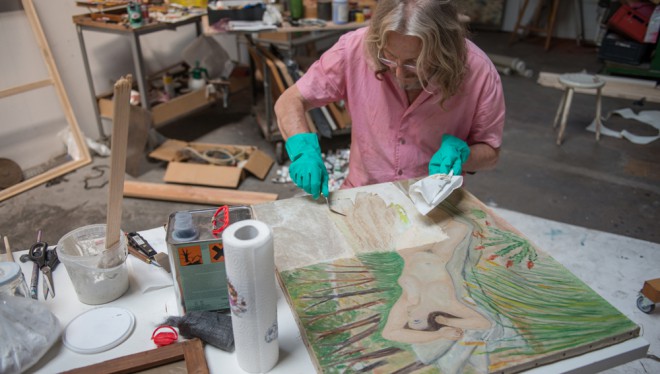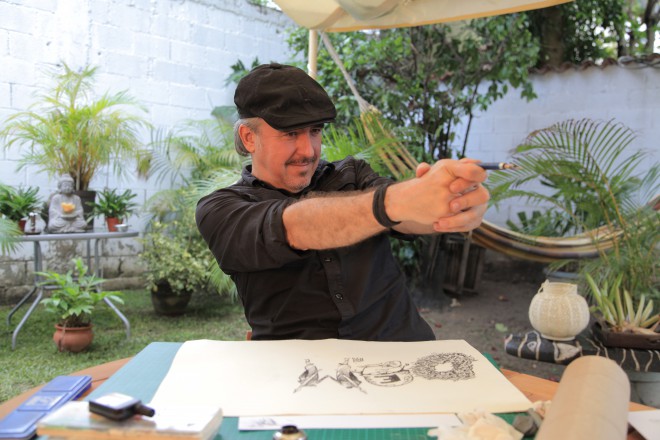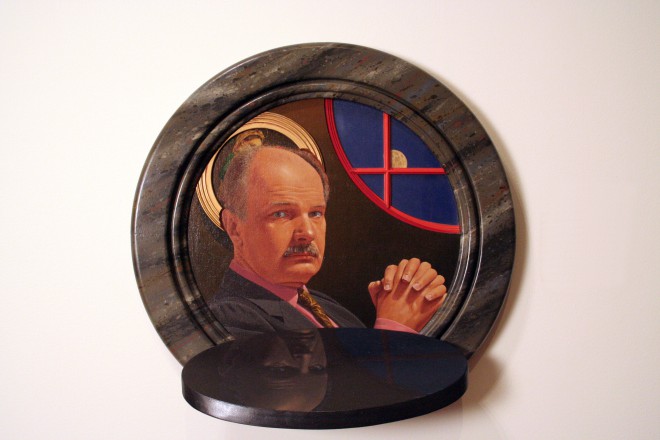2015 Reel Artists Film Festival Preview

In one of the films to be shown at this year’s Reel Artists Film Festival, the subject, an 82-year-old art patron, points out that documentary film is an art. That, indeed, taking part in his very own film is art. In this same spirit of discussing the meta nature of creating, the Reel Artists Film Festival will show three feature-length documentaries (along with a series of documentary shorts) that tackle relevant issues in contemporary art. The themes of these films ask big questions: At what point is a painting a forgery? What social responsibilities should cartoonists hold themselves to? And, finally, is a commissioner of art selfish or selfless?
I think these questions are all worth asking, and they’re all the more engaging when tackled via the colorful subjects in each of these films. I got the chance to preview the three full-length documentaries ahead of the festival’s March 26 opening in Ontario, and hopefully the reviews below will whet your palate. For those who can see the films in person, each screening will be followed by a panel discussion or guest speaker you won’t want to miss out on. You can see the full schedule and get more information here.
Beltracchi: The Art of Forgery
Director: Arne Birkenstock
Screening: March 26 – 8:00 pm, March 27 – 9:10 pm
Keynote Speaker(s): Arne Birkenstock, producer, director and screenwriter of Beltracchi: The Art of Forgery, will introduce the film, and then art critic Blake Gopnik will give a talk on the subject of art forgeries.

I probably have to confess that one of my favorite movies of all time is Catch Me If You Can, the Spielberg-directed caper about a teenager who gets away with convincing the world he’s an airline pilot, attorney, and even a doctor. So, naturally, director Arne Birkenstock’s documentary about Wolfgang Beltracchi, a man who spent nearly 40 years selling his own replicas of master paintings for millions of dollars, was right up my alley.
But Birkenstock’s film is not an action thriller—it firmly takes place in the present day with a nostalgic Beltracchi (along with his wife and partner in crime) looking back on some of their “success stories.” When not looking backward, much of the film takes place in their studio, allowing Beltracchi to show us some of the tricks of the trade, everything from peeling off the paint of old canvases (to reuse them) to capturing that perfect this-painting-is-totally-old smell.
The filmmakers are ever so careful to give us a full hour of lust for art before showing us the benefits of Beltracchi’s seedy endeavors: a mansion that might make Mark Zuckerberg jealous, with open glass windows and a magnificent view. Indeed, the editing is key here. By only allowing us see the studio at first, we’re able to feel bad for this passionate older man who is about to lose his home for the much colder confines of a German jail. As the film goes on, Beltracchi’s cockiness is more apparent (apparently Da Vinci is “easy to replicate”), but we’ve already been seduced by his energy and love for detail by this point. Thanks to careful editing and scripting, we go back and forth between being enchanted and remembering, “Oh, no wait. This is bad.”
The film also takes care to interweave as many sides of the story as possible—the buyers, the museum purchasers, and Beltracchi’s family—in order to build the full scope of what circumstances had to exist to let a man get away with this for four decades. But these diversions from the main plot never fully puncture the heart of the film: the childlike thrill of doing something naughty and damn near getting away with it.
Cartoonists: Foot Soldiers of Democracy
Director: Stéphanie Valloatto
Screening: March 27 – 6:00 pm | March 28 – 8:15 pm
Keynote Speaker(s): At the March 27 screening, producer Stéphanie Valloatto will introduce Cartoonists: Foot Soldiers of Democracy, and then moderate a panel discussion on political cartooning in Canada with cartoonists Bruce MacKinnon and Brian Gable and editor Haroon Siddiqui. At the March 28 screening, Stéphanie Valloatto will introduce the film, and John Ralston Saul will give the keynote address on the theme of freedom of speech.

French director Stéphanie Valloatto’s documentary Cartoonists: Foot Soldiers of Democracy couldn’t be more timely, especially after the attack this past January on the Parisian satirical weekly Charlie Hebdo. Valloatto takes a broad lens in this expose on the political cartoonist, interviewing at least a dozen illustrators from anywhere and everywhere: Russia, France, Israel, Caracas, Mexico, Tunisia, and the USA. As the attack in Paris demonstrates, hostility toward individuals who would dare question the status quo is hardly limited to non-democratic nations, and cartoonists share their struggles on obnoxious restrictions, like an artist who gets around a ban on depicting a leader’s likeness by drawing him as a banana, to terrifying burdens like friends and colleagues going missing or turning up dead. But even when one’s life isn’t on the line, the obstacles are real. Jeff Danzinger, an American political cartoonist for the New York Times, points out the irony of working for an institution that relies on big business to stay afloat but having a job that requires critiquing those same deep pockets.
At nearly two hours, the film could do with a bit of editing—the lengthy feeling might have something to do with the lack of a coherent narrative (this is really a collection of loosely related interviews). Perhaps, it’d be easier to feel invested with less subjects, allowing the individual political climates time to get a little fleshed out. But the breadth the filmmakers cover does have some advantages. Lest we believe the political cartoon is purely a western concept, Valloatto’s wide lens seems to imply that Maya Angelou was all too right when she said, “We are more alike, my friends, than we are unalike.” Image as satire is a human concept, and the the heart of this film is giving voice to the extraordinary men and women who want to keep overarching governments in check. The fight to maintain the voice to do so is universal.
The image that stood out the most to me was a cartoon made of one of their own: Ali Ferzat is a Syrian political cartoonist who was brutally attacked by President Bashar al-Assad’s soldiers while living in Damascus. Not disguising the attack’s primary motivation, Assad’s henchman took special care to break all of his fingers. The resulting comic shows Ferzat in a hospital bed, black and blue with bruises and with casts on both hands. But above the casts, he’s making peace signs and a caption reads: “It hurts when I laugh but when I think that Assad is afraid of a pencil, LOL!” More than any other image it shows that the work done by these artists aren’t cheap shots by third parties several steps removed from the conflict—they live their fight for democracy, and in this case, the pen really is mightier than the sword.
Patron Saint
Director: Michael Kainer
Screening: March 28 – 5:30 pm
Keynote Speaker(s): Director Michael Kainer will introduce the film and moderate a panel discussion with artists Rae Johnson, Phil Richards, Andy Fabo and Max Streicher. Janusz Dukszta, art patron and subject of the film, will also be in attendance.

When I studied writing at an art school, my color theory professor let me write a short story for my final project—using words to depict translucency, saturation, and temperature instead of a paint brush. In a similar way, director Michael Kainer paints a portrait of Canadian art collector Janusz Dukszta in his delightful 70-minute expose on the man. But Dukszta is no ordinary collector. From every crevice of his Ontario house, you’ll find sculptures, paintings, and drawings of just one subject: himself. The public exhibition of these works, once and for all showcasing the 90 portraits commissioned by Dukszta over the course of 50 years, serves as the catalyst for a film that’s both charming and unexpectedly insightful.
Standing on a podium before all the gallery’s guests, a curator posits the filmmaker’s primary concern: Is Dukszta’s collection simply an act of supreme narcissism? But this premise is quickly dismissed as Kainer interviews the many artists and colleagues that make up Dukszta’s circle of friends. “I can’t find anyone who actually dislikes him,” Kainer confesses from offscreen during an interview.
Indeed, the film feels like both a defense of one man—long live the patron of the arts, may as well be its subtitle—but it also feels like a defense of portraiture. It easily succeeds in both regards. Many documentaries have scoured the trenches of the fine artist, the dancer, the musician who can no longer make a living, but in Patron Saint, we see a glimpse of how one man can galvanize an art scene just by respecting young artists enough to pay them their due. We see the confidence an artist builds by being shown the respect a dollar represents. And we see more taboo topics—Dukszta went through a phase where placing himself into classic religious works seemed like it might be a bit of fun—discussed with a certain thoughtfulness, not readily dismissed as disrespectful and self-serving. The film is well-served by an incredibly eloquent group of characters (including Dukszta himself) that elevate the film to a discussion of art interpretation. “Sometimes I think the self portraits are a pre-text for Janusz to have a close encounter with an artist,” suggests curator Gordon Hatt. “Someone who … may bring him in contact with whatever you want to call it: beauty, refinement, intellect, or profound emotion.” Those types of gems keep coming and coming.
Beyond the interviews, a foray into Dukszta’s past as a refugee from Poland during World War II grounds the film in history and goes a long way in defining his motivations. Kainer did his homework, and the result is just as impactful as any other evocative piece of art. Is Dukszta a narcisstic man? Quite possibly. But he’s also honest and more than willing to show a little vulnerability. What more could you want from the subject of a painting—or a film?
